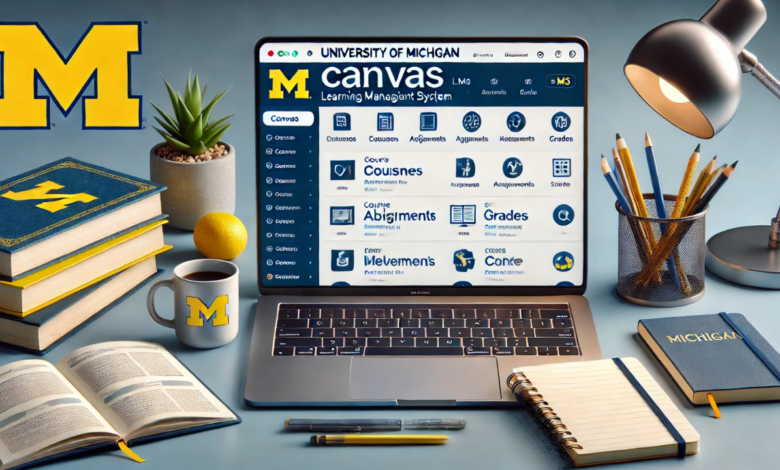Ultimate Guide to Canvas UMich: Navigating the University of Michigan’s Learning Management System

The University of Michigan (UMich) uses Canvas as its official Learning Management System (LMS), providing students and faculty with a platform for managing coursework, grades, and communication. Whether you’re a new student or a faculty member looking to explore Canvas more effectively, this guide will walk you through everything you need to know. From getting started to mastering advanced features, Canvas UMich offers an array of tools to enhance your academic experience.
1. Getting Started with Canvas UMich
1.1 What is Canvas UMich?
Canvas is an online platform that allows students, instructors, and staff at the University of Michigan to access and manage course materials, grades, and assignments. The system is designed to streamline communication, simplify assignment submissions, and offer an organized space for managing academic work. For students, Canvas serves as the digital backbone of their academic life, where all class-related materials, announcements, and assignments are housed.
Canvas is much more than just a digital syllabus. It offers tools like integrated video content, peer-reviewed assignments, and real-time updates on grades and assignments. This centralized system helps to reduce paperwork, increase efficiency, and ensure that both students and faculty can stay organized. In the past, many universities relied on various disconnected platforms, but with Canvas, everything you need for class management is in one place. Whether it’s managing coursework, collaborating with peers, or communicating with instructors, Canvas offers an intuitive and user-friendly interface that ensures academic success.
1.2 How to Access Canvas UMich

To access Canvas UMich, students and faculty need an active UMich login account. To begin, visit the official Canvas website (canvas.umich.edu) and log in using your unique UMich credentials. If you’re a student or faculty member at the university, your login details will be provided by the University of Michigan’s IT services. Once you’re logged in, you will be able to view your personal dashboard, where you can access all of your enrolled courses, assignments, and class resources.
One of the key benefits of Canvas UMich is its flexibility—students and faculty can access the system from any device. Whether you’re using a computer, tablet, or smartphone, Canvas is mobile-responsive, meaning you can check assignments, submit work, or send messages to instructors on the go. The mobile app provides an easy-to-navigate interface that complements the desktop version of Canvas, so you don’t miss any updates, whether you’re in class or on your commute.
1.3 Customizing Your Canvas Account
Canvas allows you to personalize your user experience in a variety of ways. You can adjust your profile, set preferences for notifications, and even choose how you want to be alerted about new assignments, grades, and announcements. In your profile, you can upload a profile picture and provide additional information about yourself, creating a more personalized experience both for you and for your peers or instructors who view your profile.
The notification system is one of Canvas’s most valuable features. It helps you stay on top of deadlines and updates by allowing you to set specific preferences for what kinds of notifications you’d like to receive, and how often you want to receive them. You can choose to get notifications via email, mobile push, or even through the Canvas app. Customizing these notifications ensures that you’ll never miss an important deadline or communication from your instructor, helping to reduce the stress that often comes with managing academic responsibilities.
2. Key Features of Canvas UMich
2.1 Course Dashboard and Navigation
One of the first things you’ll notice after logging into Canvas UMich is the course dashboard. This is the central hub where you can access all of your enrolled courses. The layout of the dashboard is clean, straightforward, and easy to navigate. Each course is displayed as a tile, and you can see relevant information, such as upcoming deadlines, announcements, and the course’s overall progress.
Canvas organizes everything in a way that allows students to easily view and manage their workload. The dashboard features tools that give you an overview of assignments, discussions, quizzes, and any updates from your instructors. You can even filter assignments by due date to ensure that you’re always aware of upcoming work. By providing real-time updates, Canvas ensures that you’re always prepared, and nothing slips through the cracks. The course dashboard also enables seamless access to course materials, which can include lecture slides, readings, video lectures, and more.
2.2 Assignments and Grading
Canvas UMich makes assignment submission and grading a streamlined process. Students can easily submit assignments directly through the platform. Whether it’s an essay, project, or quiz, Canvas allows for file uploads in various formats, including Word documents, PDFs, and multimedia files. Your instructor can then grade your work directly within the system and provide detailed feedback.
Once grades are posted, students can track their performance via the gradebook. The gradebook in Canvas is updated in real-time, meaning you always have access to your most up-to-date grades. You can view the grading rubrics your instructor used, which can help you understand how your work was assessed. This transparency helps students learn and improve by understanding where they may have missed points and how they can perform better in future assignments.
2.3 Communication Tools
Communication is key in any learning environment, and Canvas UMich excels in this area. With tools like the Canvas Inbox, students and instructors can send and receive messages quickly. The Inbox functions much like an email system, but within Canvas itself, providing a centralized space for academic-related communication. Students can easily ask questions about assignments, request extensions, or clarify course materials without leaving the platform.
Additionally, Canvas allows instructors to post announcements to keep students informed about any updates or changes to the course. These announcements can include reminders about upcoming exams, class cancellations, or important deadlines. Discussion boards are another fantastic way to interact with peers, collaborate on group projects, and discuss course topics. The ability to easily communicate through Canvas helps to bridge the gap between face-to-face and remote learning.
2.4 Calendar and Scheduling
The Canvas calendar feature is an essential tool for keeping track of academic deadlines. It automatically populates with important dates from your enrolled courses, including assignment deadlines, exam dates, and scheduled class sessions. This means that as soon as you log in, you can see a clear view of your upcoming responsibilities.
Students can also add personal events to the Canvas calendar, such as meetings, personal reminders, and social events. This makes it easier to manage your academic schedule alongside your personal commitments. You can also set up reminders for specific dates to ensure you don’t forget important tasks. For those who prefer to have everything in one place, Canvas can sync with external calendar applications, providing a seamless integration of both academic and personal events.
3. Advanced Canvas Features for UMich Students and Faculty
3.1 Integrations with Other UMich Tools
Canvas UMich integrates seamlessly with a variety of other tools and resources provided by the university. Whether it’s cloud storage services like Google Drive or OneDrive, or university-specific systems like Library Course Reserves, Canvas enables students and faculty to easily upload and share documents from these platforms. This integration saves time and ensures that all academic resources are easily accessible.
One of the key advantages of using Canvas is its support for multimedia content. Instructors can upload video lectures or share multimedia resources, and students can participate in video-based assignments or peer reviews. By supporting multiple file types and allowing integration with university tools, Canvas ensures that all resources are available within a single platform, improving the overall educational experience.
3.2 Collaborating in Groups
Canvas enhances collaboration among students through its group features. Students can form or be assigned to groups for projects, where they can collaborate on assignments, share files, and engage in discussions. The platform includes tools like group discussions, file sharing, and collaborative document editing, which make group work more efficient.
Instructors can also monitor group progress and provide feedback, ensuring that each group stays on track. Whether working on a group paper, presentation, or project, Canvas offers everything needed to collaborate effectively. The platform’s seamless integration with services like Google Docs and Microsoft Teams further enhances its usefulness for group-based tasks.
Conclusion
Canvas UMich is a comprehensive and user-friendly platform that facilitates every aspect of academic life at the University of Michigan. From managing assignments and grades to collaborating with peers and communicating with instructors, Canvas streamlines the student experience and ensures that all resources are in one place. By customizing your profile, using integrated tools, and staying organized with the calendar and notifications, you can optimize your academic performance. Students and faculty alike can benefit from the platform’s advanced features, ensuring that everyone stays connected and on track.
You May Also Read: https://bestusatime.com/sky-bri-net-worth/



